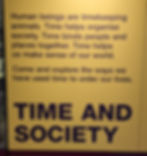Cows don't know what time it is!
- Marie Laure
- 13 hours ago
- 3 min read

In the 1950's, the reason given for "changing the clocks" twice a year, was the farmers needed more daylight.
"The cows don't know what time it is!", said a long-time farmer after all these years.
In the 1970's during a man-made "energy crisis", I rose early to get in long lines with my neighbors to buy my share of gasoline for the week. Daylight Savings, fell in line with saving energy by providing more daylight.
Okay . . . if you say so.
Here we are in 2025, coming up with reasons for ending this time-honored tradition. Arizona and Hawaii do not follow the rest of US, sticking instead to the same time year-round.
Several states are considering doing the same, Florida among them. I generally do not agree with what comes out of this state's legislature, but this time (pun intended), I am not opposed. Why not? I do not want to manipulate Father Time, anymore than we already have.

There is a long history behind how we got here that begins in Greenwich, England.
Read on, if you have the time:
Essentially, mean time is clock time rather than solar (astronomical) time.
Solar time varies throughout the year, as the time interval between the Sun crossing a set meridian line changes.
But each day measured by a clock has the same length, equal to the average (mean) length of a solar day. It’s a way of standardising and regularising time so we can all know exactly what time it is for our (or anyone’s) location.
Today GMT is reckoned from one midnight to the next.
What does GMT stand for?
GMT stands for Greenwich Mean Time, the local clock time at Greenwich. From 1884 until 1972, GMT was the international standard of civil time. Though it has now been replaced by Coordinated Universal Time (UTC).
How did Greenwich Mean Time begin?
It wasn’t until the invention of the pendulum clock in the 1650s that it was possible to work out the relationship between mean (clock) time and solar time.
John Flamsteed came up with the formula for converting solar time to mean time, and published a set of conversion tables in the early 1670s. Soon after, he was appointed as the first Astronomer Royal and moved into the new Royal Observatory in Greenwich.
Here he had the best pendulum clocks installed and set them to the local time. This was Greenwich Mean Time, or the average time when the Sun crossed the meridian at Greenwich. At first though, Greenwich time was only really important to astronomers.
I prefer the Greeks' version of Kairos over Chronos time. The latter is self-explanatory, but the former requires at least a few words. Kairos is non-linear allowing for anything to happen at just the right time to be meaningful. There are myriad examples throughout Greek mythology and the Bible. But, here in our own time, Kairos is always right around every corner, if you stop to think about it.
One small example of seeing Kairos as it happens is in the photo above with the clock face "Liverpool Street Station". Contrary to what you might think, this photo was not taken in London. It was taken the evening before my flight to London when I stayed overnight on the outskirts of Orlando at the historic Park Plaza.
Restless before the flight, I got up in the wee hours for a cup of tea. Nobody but the desk clerk was around. As I waited for the kettle to boil, I looked around at the surrounding memorabilia scattered throughout the lobby. I looked above my head and saw what I had yet to see: the clock with the insignia LS for Liverpool Street Station. I had a train ticket for that station in my suitcase. Coincidence? Serendipity, if you please. Kairos time had confirmed my destiny before I stepped foot off the plane an ocean away.

Mystics call Kairos "deep time" because it eludes all the relative time-sensitive issues by which we plan and live.
Changing the clocks twice per year, is one way of staying stuck in Chronos, thwarting Kairos from expanding our way of relating to time. I think we would get used to it, and might even enjoy keeping up with Father time, instead of running from it.
“All we have to decide is what to do with the time that is given us.” – J.R.R. Tolkien

